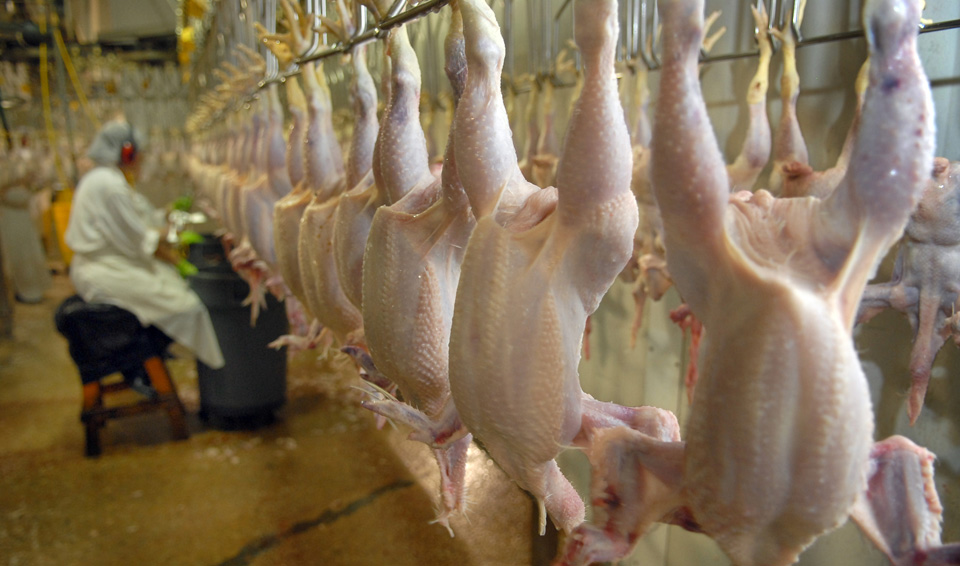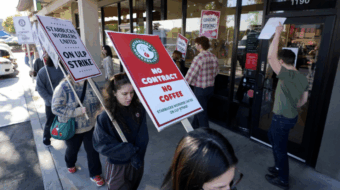
WASHINGTON—An utter lack of speed limits may be a good idea on empty expressways in Germany, but it’s a terrible idea for chicken plant processing lines in the U.S., the union representing poultry processing workers says.
Which is why the United Food and Commercial Workers, the Southern Poverty Law Center, Oxfam and other organizations to strongly oppose the speed-up scheme, pushed by the poultry processors’ lobby, the National Chicken Council.
Some 20 chicken plants now run their production lines at 175 birds per minute, a speed adopted over the strong protests of both UFCW, which represents poultry plant workers, and the Government Employees, who represent the nation’s poultry inspectors.
That speedup, from 140 birds per minute, was so unsafe, the inspectors said, they were forced to picket their own bosses at the Agriculture Department.
AFGE said then that all the processors wanted was to increase their profits and cut USDA inspections, too. This time, they didn’t mention profits and their letter said safety would not be compromised, because a faster speed would encourage more plant owners to join the USDA’S “new poultry inspection system” – — which, though processors do not say so, lets plant managers, not USDA, inspect chickens.
Their 13-page letter in September to USDA’s Food Safety and Inspection Service admits letting chicken processing plants race birds by workers with no speed limits would save the industry money, though it does not say how much. It also does not admit, as outside reports show, that 71 percent of poultry processing workers earn less than the U.S. poverty line.
The poultry processors also say their no-speed-limit demand “is consistent with” the GOP Trump administration’s deregulatory agenda. And the Chicken Council claims the faster speeds won’t decrease worker safety, and notes deaths and injuries on the job fell by more than 80 percent in the past 20 years.
The UFCW, the Southern Poverty Law Center and the animal rights groups said the chicken council’s proposal would hurt the workers, most of whom are women, members of minority groups, or both.
The latest federal statistics, from 2016, show women were 27 percent of poultry processing plant workers, 19.8 percent were African-Americans and 34.6 percent were Hispanic-named.
“The implications of this rule change are striking,” UFCW President Marc Perrone wrote to USDA in a formal protest. “Industry statistics show poultry workers are at twice the risk of being injured on the job compared to other workers and suffer illnesses at a rate that is seven times as high.
“A 2016 report from the Government Accountability Office (GAO) showed that forcing lines to move faster will expose poultry workers to higher rates of injuries and illnesses,” he continued.
“Increased line speeds will also make it harder for both federal inspectors and quality control workers to properly check birds for contamination that could make consumers sick.
“Given the facts noted above, the petition from the NCC clearly poses a dangerous risk to American families,” Perrone declared.
The Southern Poverty Law Center told USDA the speedup of the chicken processing lines would hurt workers, notably in the Southeast, the heart of chicken processing in the U.S. Though the center did not say so, most chicken plant workers are women, minorities and/or undocumented, and thus most often exploited.
A 2014 SPLC report, Unsafe At These Speeds, revealed injuries to chicken plant workers in Alabama, their test state, were vastly underreported. One-third of 300 workers interviewed in Alabama chicken plants had carpal tunnel syndrome and three-fourths suffered hand and wrist nerve damage.
“Unfortunately, nothing has changed,” SPLC told the federal agency.
“Poultry processors’ injury and illness logs” filed with the federal Occupational Safety and Health Administration “often do not reflect” actual injuries on the job.
“Line speeds in poultry plants are still too fast and workers are still suffering for the industry’s profit. These fast line speeds and the repetitive nature of the work on the line, cause musculoskeletal disorders that leave workers permanently disabled and unable to work.”
The totally crippled workers then must depend on disability payments and other public money to live, the SPLC noted.
“Any reversal on poultry line industry speeds” – including no speed limits at all – “would hurt workers’ health and only serve to line the industry’s pockets,” the anti-poverty group concluded.
The center and the others agreed with UFCW’s conclusion: “For the sake of keeping hard-working families safe – whether they’re preparing, buying, or eating chicken – the USDA must reject this petition.”










